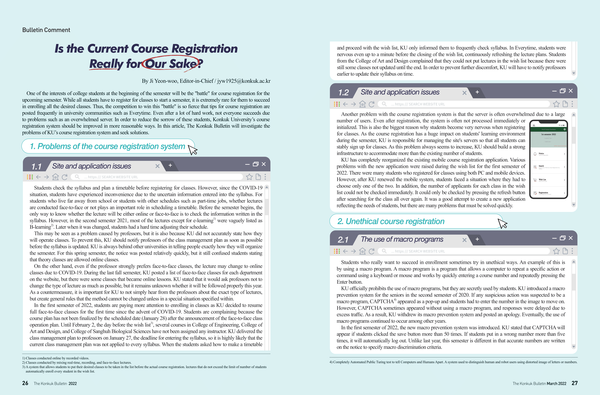

One of the interests of college students at the beginning of the semester will be the "battle" for course registration for the upcoming semester. While all students have to register for classes to start a semester, it is extremely rare for them to succeed in enrolling all the desired classes. Thus, the competition to win this "battle" is so fierce that tips for course registration are posted frequently in university communities such as Everytime. Even after a lot of hard work, not everyone succeeds due to problems such as an overwhelmed server. In order to reduce the sorrow of these students, Konkuk University’s course registration system should be improved in more reasonable ways. In this article, The Konkuk Bulletin will investigate the problems of KU’s course registration system and seek solutions.
1. Problems of the course registration system
1.1 Site and application issues
Students check the syllabus and plan a timetable before registering for classes. However, since the COVID-19 situation, students have experienced inconvenience due to the uncertain information entered into the syllabus. For students who live far away from school or students with other schedules such as part-time jobs, whether lectures are conducted face-to-face or not plays an important role in scheduling a timetable. Before the semester begins, the only way to know whether the lecture will be either online or face-to-face is to check the information written in the syllabus. However, in the second semester 2021, most of the lectures except for e-learning1) were vaguely listed as B-learning2). Later when it was changed, students had a hard time adjusting their schedule.
This may be seen as a problem caused by professors, but it is also because KU did not accurately state how they will operate classes. To prevent this, KU should notify professors of the class management plan as soon as possible before the syllabus is updated. KU is always behind other universities in telling people exactly how they will organize the semester. For this spring semester, the notice was posted relatively quickly, but it still confused students stating that theory classes are allowed online classes.
On the other hand, even if the professor strongly prefers face-to-face classes, the lecture may change to online classes due to COVID-19. During the last fall semester, KU posted a list of face-to-face classes for each department on the website, but there were some classes that became online lessons. KU stated that it would ask professors not to change the type of lecture as much as possible, but it remains unknown whether it will be followed properly this year. As a countermeasure, it is important for KU to not simply hear from the professors about the exact type of lectures, but create general rules that the method cannot be changed unless in a special situation specified within.
In the first semester of 2022, students are paying more attention to enrolling in classes as KU decided to resume full face-to-face classes for the first time since the advent of COVID-19. Students are complaining because the course plan has not been finalized by the scheduled date (January 28) after the announcement of the face-to-face class operation plan. Until February 2, the day before the wish list3), several courses in College of Engineering, College of Art and Design, and College of Sanghuh Biological Sciences have not been assigned any instructor. KU delivered the class management plan to professors on January 27, the deadline for entering the syllabus, so it is highly likely that the current class management plan was not applied to every syllabus. When the students asked how to make a timetable and proceed with the wish list, KU only informed them to frequently check syllabus. In Everytime, students were nervous even up to a minute before the closing of the wish list, continuously refreshing the lecture plans. Students from the College of Art and Design complained that they could not put lectures in the wish list because there were still some classes not updated until the end. In order to prevent further discomfort, KU will have to notify professors earlier to update their syllabus on time.
1.2 Site and application issues
Another problem with the course registration system is that the server is often overwhelmed due to a large number of users. Even after registration, the system is often not processed immediately or initialized. This is also the biggest reason why students become very nervous when registering for classes. As the course registration has a huge impact on students' learning environment during the semester, KU is responsible for managing the site's servers so that all students can stably sign up for classes. As this problem always seems to increase, KU should build a strong infrastructure to accommodate more than the existing number ofs tudents.
KU has completely reorganized the existing mobile course registration application. Various problems with the new application were raised during the wish list for the first semester of 2022. There were many students who registered for classes using both PC and mobile devices. However, after KU renewed the mobile system, students faced a situation where they had to choose only one of the two. In addition, the number of applicants for each class in the wish list could not be checked immediately. It could only be checked by pressing the refresh button after searching for the class all over again. It was a good attempt to create a new application reflecting the needs of students, but there are many problems that must be solved quickly.
2. Unethical course registration
2.1 The use of macro programs
Students who really want to succeed in enrollment sometimes try in unethical ways. An example of this is by using a macro program. A macro program is a program that allows a computer to repeat a specific action or command using a keyboard or mouse and works by quickly entering a course number and repeatedly pressing the Enter button.
KU officially prohibits the use of macro programs, but they are secretly used by students. KU introduced a macro prevention system for the seniors in the second semester of 2020. If any suspicious action was suspected to be a macro program, CAPTCHA4) appeared as a pop-up and students had to enter the number in the image to move on. However, CAPTCHA sometimes appeared without using a macro program, and responses were delayed due to excess traffic. As a result, KU withdrew its macro prevention system and posted an apology. Eventually, the use of macro programs continued to occur among other years.
In the first semester of 2022, the new macro prevention system was introduced. KU stated that CAPTCHA will appear if students clicked the save button more than 50 times. If students put in a wrong number more than five times, it will automatically log out. Unlike last year, this semester is different in that accurate numbers are written on the notice to specify macro discrimination criteria.
2.2 Buying lectures with money
Some students feel nervous in the huge competition rate that they pay money to buy lectures. In Everytime, there were a lot of posts such as asking to sell and buy lectures, offering prices for popular classes. Some students who are planning to take a semester off or who have credits left intentionally try to apply for popular classes to earn money. If the seller cancels his or her lecture enrollment at a specific time, the buyer registers immediately.
Currently, KU implemented a new system similar to Kookmin University’s “cancellation-application delay system”, which intervals the time for remaining spots to appear on the registration system. However, criticism has been raised that this system only applies for the registration period for all grades. It is also not an essential solution for overheating class registration, as different time intervals are given to each canceled spot. The reporter proposes to make alternatives such as opening all canceled lectures at a specific time, so that students do not have to wait in front of computers all day. In fact, some classes had pop-ups with the time it will release a remaining spot but KU did not specify the criteria for this.
3. Less supply than demand
One of the complaints raised every semester is that the number of students for each class is far too few. The number of students in departments is set, but demand is increasing gradually due to multiple majors and minor majors. In the case of enrollment for multiple and minor major students, each department has different rules. Most majors allow multiple and minor major students to apply for the course during the main course registration period. However, in some majors, such as the Department of Digital Culture and Contents, it is only possible to apply during the entire course registration period. Some say that if multiple and minor majors register with other general students, it will be a disadvantage for the main major students. However, it may be difficult to complete the major if multiple and minor majors only apply during the entire course registration period. KU is relatively free to choose multiple and minor majors compared to other schools, so the number of students for enrollment is considerably large. It seems necessary to increase the number of students for each class or reduce the number of students of multiple or minor majors according to the school’s situation.
When students are in the worst situation, they have no other choice but to send personal e-mails to the professor to ask him or her to accept additional students. As the number of such students is not small, it is difficult for the professors to accept all of them. KU has reduced the number of students to 80 percent by conducting face-to-face lectures this semester, and the battle for enrollment is expected to intensify. KU needs to create additional courses or other follow-up measures as much as reducing the number of students.
There is a limit to simply increasing the number of lectures. Since the enactment of the Instructor Act in August 2019, the number of courses at universities has plummeted. The Instructor Act was introduced to stabilize the employment and improve the treatment of part-time university instructors. It says that instructors must be given teacher status for at least one year and the re-appointment process must be guaranteed for three years. However, controversy arose as universities decreased the number of courses by reducing the number of part-time instructors due to the burden of labor costs. Currently, the number of students per full-time faculty member of KU is 28.79 as of 2021. This is 12.5 percent higher than the public universities’ average of 25.6 and more than twice of the average of Seoul National University, 13.64 students. The high number of students taken by each instructor means that there is a shortage of instructors, and the number of courses offered will be limited because there is a limit to the number of courses each professor can teach. KU should solve the fundamental problem of lack of instructors for students.
4. Structural problems of course registration
Are only students responsible for the failure to register for the course? The blame is on school if it does not actively change its policy for students.
For example, Yonsei University implemented a “bidding system” and a “waitingo rder system.” First, the bidding system is a course registration system in which a certain amount of mileage is provided to individual students for each semester and students distribute their mileage for each subject. If the mileage is tied, the "time ticket system" is applied, not on a first-come, first-served basis, but according t othe priority of the students’ grade and major.
During the additional registration period, the waiting order system is used. It is a system in which the students who fail to apply for the course have the waiting order, and if the previous applicant cancels, the next student can enter. However, students argue that the waiting order system does not improve the fundamental problem of the unfair class registration system based on a first-come, first-served basis. On the other hand, some say it is the most efficient and fair way because the distribution is needed as not everyone can listen to the lectures they want since the number of students that can be accepted is limited.
Among the systems mentioned, the waiting order system was a pledge made by Yonsei University student council candidate in 2013 to investigate and solve the problems of class registration. The school immediately accepted the new system and introduced a new class registration system by adding the bidding system and time ticket system. KU should also listen more to the voices of students, identify the causes of the current course registration problems, and quickly come up with realistic measures.
Since KU’s insufficient countermeasures have lasted too long, it is now natural for students to blame themselves for their dull fingers rather than having a sense of the problem with the system. The timetable will become more important for students when school life begins from the first semester in 2022. Some students may be forced to take a semester off because they cannot register for classes they want to take even though they pay millions of won for tuition. It is a natural right for students to take courses that he or she wants or needs after paying for the tuition. However, the structural problems of course registration cause students inconveniences that cannot be solved through their own efforts. Nevertheless, students must endure all the disadvantages incurred in the event of failure to apply for classes. The reporter suggests that this semester will be an opportunity for KU to solve the fundamental problems of course registration as soon as possible and change the enrollment system significantly.

